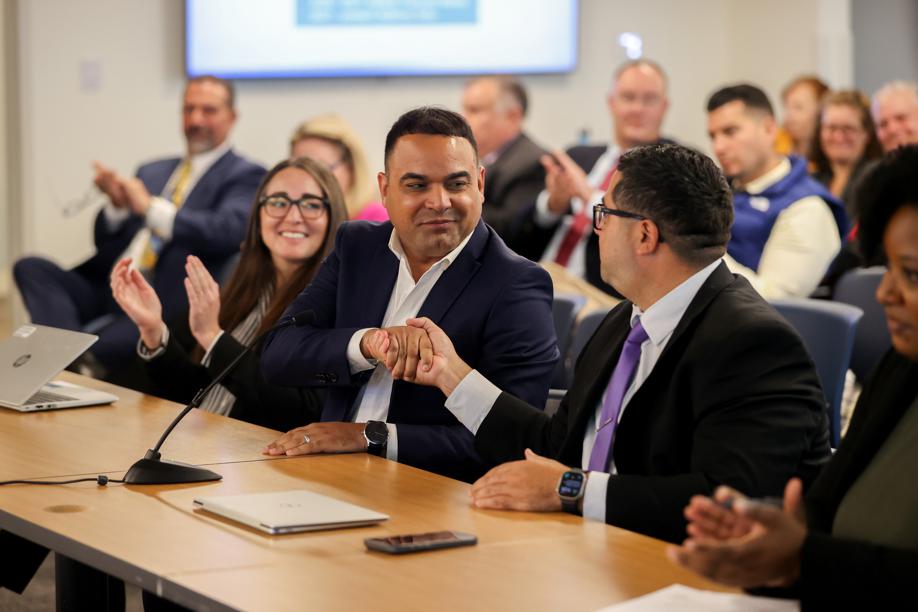EVERETT — Following nearly a decade under state control, Holyoke Public Schools, once considered the worst-performing district in Massachusetts, will be released from its state receivership, officials announced Tuesday.
The decision, which was met by a hearty round of applause from those attending a state board meeting at the Everett-based headquarters of the Department of Elementary and Secondary Education, returns local control to a Western Massachusetts community challenged by widespread poverty and where student need is significant. Last school year, 85 percent of Holyoke’s nearly 5,000 students were considered low-income, while 30 percent had disabilities, and almost 20 percent were still learning English.
“We are very proud of the work that has been done in Holyoke,’’ said acting state Education Commissioner Russell Johnston, noting the release would be “provisional.’’ Following a transition period, the receivership would officially end July 1, 2025, Johnston said.
The state education board voted to place Holyoke under receivership in 2015 following years of languishing academic performance. Under receivership, the local School Committee and superintendent were stripped of their decision-making power and a state-selected leader was installed. Under Massachusetts law, the state education board can take control of underperforming districts and appoint a so-called receiver who is to execute a turnaround plan.
Critics had assailed the state takeover as political disenfranchisement of a community in which 4 out of every 5 students was Latino. (That number has slightly increased since, according to state data.)
But proponents of the receivership said reform was necessary to ensure the district’s marginalized population received a high-quality education.
At the time, the district’s graduation rate was the lowest in the state, and its dropout rate was among the highest. What’s more, the district’s neediest students, including English learners and students with disabilities, had fallen even further behind. Local control of the schools was also “consistently racist,’’ according to Simone Fried, an assistant professor at the University at Buffalo’s Graduate School of Education, who studied the Holyoke takeover. Parents who spoke with Fried for her research complained that Latino culture was rarely embraced in the schools and translation services were poor.
“I think you could argue that Holyoke’s crisis of performance was such that it was violating the rights of their students,’’ Fried said.
But under state receivership, the school district has not shown major academic improvements overall, due, at least in part, to the disruption of the COVID-19 pandemic. Although the five-year graduation rate increased substantially to 78 percent, that’s consistent with statewide trends. Meanwhile, chronic absenteeism skyrocketed through the pandemic and has come down slower than it has in other districts. Student performance on the MCAS exams also worsened. Last year, just 6 and 9 percent of Holyoke third- and eighth-graders met expectations on their math and English assessments, respectively, down from 10 and 14 percent in 2017.
The results in Holyoke mimic widespread research on state takeovers of school districts, which show they rarely improve educational outcomes but are effective at rooting out corruption and dysfunction.
Max Page and Deb McCarthy, president and vice president of the Massachusetts Teachers Association, the state’s largest teachers union, said Holyoke residents had to wait too long to regain control of their schools.
“Holyoke Public Schools suffered from decades of chronic underfunding and problematic district leadership that acutely affected students of historically marginalized communities,’’ they said in a joint statement. “The Massachusetts Teachers Association never supported state receivership as it cut off the community’s ability to democratically decide on the function and priorities of its schools.’’
Governor Maura Healey lauded the decision, calling Holyoke’s return to local control “an important step’’ that will benefit students, teachers, and families.
“I’m grateful for the hard work and partnership of [Holyoke] Mayor [Joshua] Garcia, the School Committee and the school district to make progress on ensuring all students are receiving a high-quality education,’’ Healey said in a statement. “We look forward to continuing to work together to ensure they can successfully exit receivership next year.’’
Garcia said his city is “ready to move forward,’’ but he acknowledged that challenges remain.
’’Although this is welcoming news, we certainly do not take it at all very lightly,’’ Garcia told members of the state board of education. “We understand that there’s still so much more work to do.’’
The decision to release Holyoke from its receivership prior to hitting its turnaround goals may signal a different approach to school reform efforts under the Healey administration.
Questioned by the Globe, Education Secretary Patrick Tutwiler said the administration’s focus is to be “partners first.’’
“We also need to examine at what point the partnership needs to change and look different,’’ he said. “That is absolutely the case right now with Holyoke.’’
Speaking before the board, Superintendent and Receiver Anthony Soto — a Holyoke graduate himself — highlighted other measures of progress for the district, including investments in high-quality curriculum and professional learning for teachers and administrators. The district also has increased access to prekindergarten and early college opportunities, Soto said.
English learners and students with disabilities made double-digit gains in their graduation rates during receivership, and the out-of-school suspension rate dropped from 20 percent in 2014 to 9 percent last year. The district’s dual language program also expanded and now serves more than 20 percent of Holyoke’s pre-K-8 students.
Holyoke since last year has formally been petitioning the state to come out from under receivership. Lawrence and Southbridge school districts also are under state receivership, beginning in 2011 and 2016, respectively, and advocates in those communities have called for an end to state control. Likewise, those districts also have not seen much improvement while under receivership.
Johnston said the state is continuing to monitor improvements in Lawrence and Southbridge. He did not provide a timeline for their release.
Stephen Zrike, the first receiver appointed to oversee Holyoke schools, called the news “bittersweet.’’ Zrike, who stepped down as the district’s receiver in 2020 to become superintendent of Salem Public Schools, said he was disappointed the district didn’t see more growth in student achievement, which he said was blunted by the pandemic.
Still, he believes Holyoke students are being better served today than they were 10 years ago, citing the programmatic and curriculum changes, as well as the increase in diversity among the teaching force.
“There’s a lot of things to be proud of from the department’s standpoint, but there’s also a lot of things that need to get better for kids,’’ he said. “I don’t think the work is ever done, and Holyoke faces a lot of challenges.’’
Mandy McLaren can be reached at mandy.mclaren@globe.com.
Deanna Pan can be reached at deanna.pan@globe.com.

